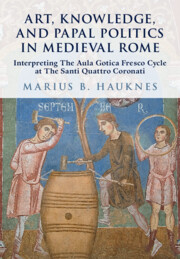 Art, Knowledge, and Papal Politics in Medieval Rome
Art, Knowledge, and Papal Politics in Medieval Rome Book contents
- Art, Knowledge, and Papal Politics in Medieval Rome
- Art, Knowledge, and Papal Politics in Medieval Rome
- Copyright page
- Dedication
- Contents
- Acknowledgments
- Introduction
- One The Santi Quattro Coronati Frescoes in Context
- Two Art, Learning, and Reflective Viewing
- Three Emblems of Time and Political Power
- Four Allegory, History, and Political Eschatology
- Five Visual and Material Entanglement in the Anagni Crypt
- Six Conclusion
- Appendix Inscriptions Appearing in the Aula Gotica Frescoes
- Bibliography
- Index
Introduction
Published online by Cambridge University Press: 30 January 2025
- Art, Knowledge, and Papal Politics in Medieval Rome
- Art, Knowledge, and Papal Politics in Medieval Rome
- Copyright page
- Dedication
- Contents
- Acknowledgments
- Introduction
- One The Santi Quattro Coronati Frescoes in Context
- Two Art, Learning, and Reflective Viewing
- Three Emblems of Time and Political Power
- Four Allegory, History, and Political Eschatology
- Five Visual and Material Entanglement in the Anagni Crypt
- Six Conclusion
- Appendix Inscriptions Appearing in the Aula Gotica Frescoes
- Bibliography
- Index
Summary
In 1995, on the Celian Hill in Rome, a team of conservators led by Dottoressa Andreina Draghi made a remarkable discovery in the fortified tower attached to the basilica of Santi Quattro Coronati. Concealed behind layers of whitewash in a vaulted hall were the remains of an extensive thirteenth-century fresco cycle (Figure I.1). The tower and hall originally formed part of a palace complex built for Stefano Conti, a high-ranking cardinal of the papal Curia who lived there from the early 1240s until his death in 1254. During this time, Cardinal Conti sponsored a vast program of murals that included the newfound hall frescoes, the well-known series of narrative paintings in the small chapel dedicated to Saint Sylvester, and a painted liturgical almanac in the chapel’s antechamber (Figures I.2 and I.3). To realize this program of fresco decorations, Conti hired the same teams of painters who had completed the large cycle of murals in the crypt of Anagni Cathedral a few years earlier.
- Type
- Chapter
- Information
- Art, Knowledge, and Papal Politics in Medieval RomeInterpreting the Aula Gotica Fresco Cycle at Santi Quattro Coronati, pp. 1 - 12Publisher: Cambridge University PressPrint publication year: 2025
